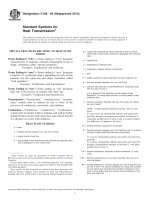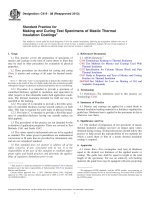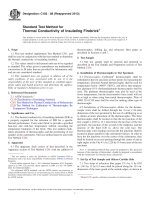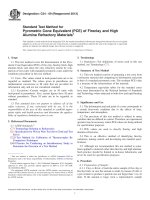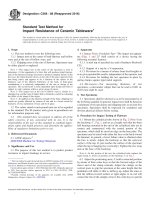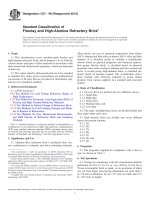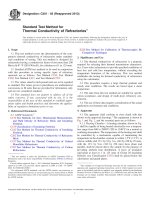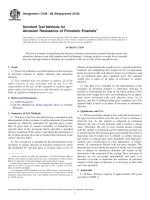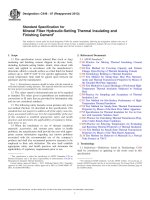Astm c 182 88 (2013)
Bạn đang xem bản rút gọn của tài liệu. Xem và tải ngay bản đầy đủ của tài liệu tại đây (102.45 KB, 3 trang )
Designation: C182 − 88 (Reapproved 2013)
Standard Test Method for
Thermal Conductivity of Insulating Firebrick1
This standard is issued under the fixed designation C182; the number immediately following the designation indicates the year of
original adoption or, in the case of revision, the year of last revision. A number in parentheses indicates the year of last reapproval. A
superscript epsilon (´) indicates an editorial change since the last revision or reapproval.
thermocouples, drilling jig, and refractory fiber paper as
described in Sections 6 and 7.
1. Scope
1.1 This test method supplements Test Method C201, and
shall be used in conjunction with that test method to determine
the thermal conductivity of insulating firebrick.
5. Test Sample
5.1 The test sample shall be selected and prepared as
described in the Test Sample and Preparation section of Test
Method C201.
1.2 The values stated in inch-pound units are to be regarded
as standard. The values given in parentheses are mathematical
conversions to SI units that are provided for information only
and are not considered standard.
1.3 This standard does not purport to address all of the
safety problems, if any, associated with its use. It is the
responsibility of the user of this standard to establish appropriate safety and health practices and determine the applicability of regulatory limitations prior to use.
6. Installation of Thermocouples in Test Specimen
6.1 Thermocouples—Calibrated3 thermocouples shall be
embedded in the test specimen at three points for measuring the
temperature. Chromel-Alumel thermocouples shall be used for
temperatures below 1400°F (760°C), and above that temperature platinum-10 % rhodium/platinum thermocouples shall be
used. The platinum thermocouples may also be used at the
lower temperatures, but the electromotive force (emf) will not
be as high as when using base-metal thermocouples. Wire of
AWG 28 (0.320 mm) shall be used for making either type of
thermocouple.
2. Referenced Documents
2.1 ASTM Standards:2
C155 Classification of Insulating Firebrick
C201 Test Method for Thermal Conductivity of Refractories
E220 Test Method for Calibration of Thermocouples By
Comparison Techniques
6.2 Installation of Thermocouples—Holes for the thermocouple wires shall be drilled through the 41⁄2-in. (114-mm)
dimension of the test specimen by the use of a drilling jig so as
to obtain accurate placement of the thermocouples. The three
thermocouples shall be located so that the hot junction of the
first couple is 0.20 in. (5.1 mm) below the hot face of the test
specimen, the junction of the second at the midpoint, and the
junction of the third 0.20 in. above the cold face. The
thermocouple wires leading out from the hot junctions shall be
located in planes parallel to the calorimeter surface. In order to
have the hot junctions over the center of the calorimeter, they
shall be located on an axis passing through the center of and at
right angles to the 9 by 41⁄2-in. (228 by 114-mm) area of the test
specimen.
3. Significance and Use
3.1 The thermal conductivity of insulating firebrick (IFB) is
a property required for the selection of IFB for a specific
thermal performance. Users select brick to provide a specified
heat-loss and cold-face temperature without exceeding the
temperature limitation of the brick. This test method establishes placement of thermocouples and the positioning of test
samples in the calorimeter. This test method must be used with
Test Method C201.
4. Apparatus
4.1 The apparatus shall consist of that described in the
Apparatus section of Test Method C201 with the addition of
NOTE 1—Insulating firebrick that cannot be prepared to this precision
because of the structure of the product, should be prepared in accordance
with the instructions for fireclay dense refractories.
1
This test method is under the jurisdiction of ASTM Committee C08 on
Refractories and is the direct responsibility of Subcommittee C08.02 on Thermal
Properties.
Current edition approved Sept. 1, 2013. Published September 2013. Originally
approved in 1943. Last previous edition approved in 2009 as C182 – 88 (2009).
DOI: 10.1520/C0182-88R13.
2
For referenced ASTM standards, visit the ASTM website, www.astm.org, or
contact ASTM Customer Service at For Annual Book of ASTM
Standards volume information, refer to the standard’s Document Summary page on
the ASTM website.
7. Set-Up of Test Sample and Silicon Carbide Slab
7.1 Two strips of refractory fiber paper 131⁄2 by 1⁄2 by 0.02
in. (343 by 13 by 0.5 mm) shall be placed along the 131⁄2-in.
dimension of the inner guard at the outside edges, as shown in
3
Method E220 specifies calibration procedures for thermocouples.
Copyright © ASTM International, 100 Barr Harbor Drive, PO Box C700, West Conshohocken, PA 19428-2959. United States
1
C182 − 88 (2013)
placing under each corner of the slab rectangular pieces of
Group 30 or 32 (see Classification C155) insulating firebrick
cut to measure 3⁄8 in. (10 mm) square and 1.00 in. (25.4 mm)
in length.
Fig. 1. Twelve strips of refractory fiber paper 2 by 1⁄2 by 0.02
in. (51 by 13 by 0.5 mm) shall be placed on the outer guard at
intervals in the pattern shown in Fig. 1. These strips serve as
spacers to prevent contact between the test material and the
calorimeter assembly. The test specimen shall be placed
centrally over the center of the calorimeter section on its 9 by
41⁄2-in. (228 by 114-mm) face, the guard brick placed at the
sides of the test specimen so as to completely cover the
calorimeter and inner guard area, and the soap brick placed
around the edge of the three brick so as to completely cover the
calorimeter assembly. The small space between the furnace
walls and the test brick assembly shall be filled with a
granulated insulating firebrick.
8. Procedure
8.1 Place the heating chamber in position, start the water
flowing through the calorimeter assembly, and supply the
current to the heating unit. Above a temperature of 1470°F
(800°C), the furnace atmosphere shall contain a minimum of
0.5 % oxygen with zero % combustibles. Take the atmosphere
sample from the furnace chamber proper, preferably as near the
test specimen as possible. Maintain the rate of water flow
through the calorimeter between 120 and 200 g/min, and
determine by weighing the quantity of water collected during a
measured time period. The mass of water collected shall be not
less than 200 g and shall be weighed to an accuracy of 60.5 g.
The rate of flow shall be constant within6 1 % during the test
period.
7.2 When testing Group 28, 30, 32, or 33 insulating
firebrick, it may be desirable to obtain test results at higher
mean temperatures than is possible with the sample set-up
described in 7.1. This can be accomplished by placing a 0.5-in.
(13-mm) thick layer of ceramic fiber-block insulation or 0.5 in.
of Group 20 insulating firebrick between the calorimeter area
and the test sample. Sufficient material is required to cover an
area 18 by 131⁄2 in. (456 by 342 mm). The solid sheet of
back-up insulation shall be ground so as to provide surfaces
that are plane and do not vary from parallel by more than
60.01 in. (0.3 mm). This shall be placed on the refractory fiber
strips described in 7.1. Additional refractory fiber strips, in an
identical pattern, shall be placed on top of the ceramic fiber
board. The test specimen and guard brick shall then be placed
as described in 7.1.
8.2 Allow the furnace to reach a condition of steady state of
heat flow (test period), which shall be that condition when the
measured flow of heat into the calorimeter varies less than 2 %
over a 2-h period, during which time the temperature difference
between the calorimeter and inner guard has not been more
than 0.05°F (0.03°C), the hot face of the test specimen has not
varied more than 65°F (63°C), and the temperature of the
water entering the calorimeter has not varied at a rate of more
than 1°F (0.5°C)/h (Note 2). Usually, 12 h or more are needed
to obtain a balance with the apparatus after a definite change is
made in the hot-face temperature.
7.3 The silicon carbide slab shall be placed over the 9 by
131⁄2-in. (228 by 342-mm) area of the three 9-in. sample brick,
and it shall be spaced 1 in. (25 mm) above the sample by
NOTE 2—Significant errors will result if the tolerances specified are
exceeded.
8.3 After the steady state of heat flow has been reached,
measure the temperature of the test specimen, the rate of water
flow through the calorimeter, and the temperature rise of the
water flowing through the calorimeter. Take at least four sets of
readings (Note 3) at approximately 30-min intervals during the
2-h holding period, and average these for the final values for
that particular heating chamber temperature. Obtain such data
when the heating chamber is maintained at the temperatures
recommended in Table 1. Temperatures other than those given
in the table may be used to obtain additional information.
NOTE 3—From these data a preliminary thermal conductivity calculation may be made, using estimated distances between thermocouple
junctions in the test specimen.
8.4 At the conclusion of the test, remove the specimen and
cut it in two, close to the thermocouple junctions. Then grind
the specimen to expose the hot junctions, and measure the
distance between their center lines to the nearest 0.01 in. (0.3
mm). If upon being cut in two the test specimen shows
abnormal internal voids or cracks, state this fact in the report,
as the results will not be representative of the material.
9. Record of Test Data, Calculations, and Report
9.1 The record of test data, the calculations, and the report
shall be made in accordance with the Record of Test Data,
Calculation, and Report sections of Test Method C201.
FIG. 1 Arrangement of Refractory Fiber-Paper Strips in Calorimeter Assemblage
2
C182 − 88 (2013)
TABLE 1 Heating Chamber Temperature
Group
Number
16
20
24
26
28
30
32
33
Bulk Density Not
Greater Than,
Recommended Temperatures for Control Points, °F (°C)
lb/ft3
g/cm3
34
40
48
54
60
68
95
95
0.54
0.64
0.77
0.86
0.96
1.09
1.52
1.52
Low
900
900
900
900
900
900
900
900
(480)
(480)
(480)
(480)
(480)
(480)
(480)
(480)
Medium
...
1400 (760)
1500 (815)
1650 (900)
1750 (955)
1750 (955)
1750 (955)
1750 (955)
High
1600
2000
2300
2600
2800
2800
2800
2800
(870)
(1095)
(1260)
(1425)
(1540)
(1540)
(1540)
(1540)
10. Precision and Bias
11. Keywords
10.1 Refer to Test Method C201 for a statement of precision
and bias.
11.1 calorimeter; insulating firebrick; refractories; thermal
conductivity
ASTM International takes no position respecting the validity of any patent rights asserted in connection with any item mentioned
in this standard. Users of this standard are expressly advised that determination of the validity of any such patent rights, and the risk
of infringement of such rights, are entirely their own responsibility.
This standard is subject to revision at any time by the responsible technical committee and must be reviewed every five years and
if not revised, either reapproved or withdrawn. Your comments are invited either for revision of this standard or for additional standards
and should be addressed to ASTM International Headquarters. Your comments will receive careful consideration at a meeting of the
responsible technical committee, which you may attend. If you feel that your comments have not received a fair hearing you should
make your views known to the ASTM Committee on Standards, at the address shown below.
This standard is copyrighted by ASTM International, 100 Barr Harbor Drive, PO Box C700, West Conshohocken, PA 19428-2959,
United States. Individual reprints (single or multiple copies) of this standard may be obtained by contacting ASTM at the above
address or at 610-832-9585 (phone), 610-832-9555 (fax), or (e-mail); or through the ASTM website
(www.astm.org). Permission rights to photocopy the standard may also be secured from the ASTM website (www.astm.org/
COPYRIGHT/).
3
